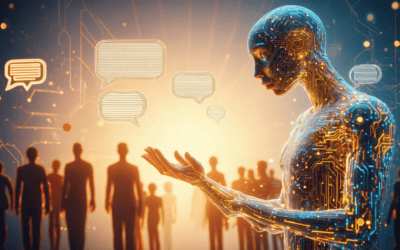In today’s fast-paced digital landscape, effective communication is more crucial than ever, and chatbot text messages are revolutionizing how businesses interact with their customers. This article delves into the transformative power of chatbots and their ability to enhance communication strategies through automated text messaging. We will explore key topics such as the functionality of a chatbot text message generator, the distinction between human and bot texts, and how to identify SMS chatbots. Additionally, we will discuss the safety of using chatbots and provide examples of chatbot messaging that can streamline your customer interactions. Join us as we uncover how integrating a text chatbot into your communication strategy can not only improve efficiency but also elevate the customer experience.
Can a chatbot send text messages?
Yes, chatbots can send text messages, and they are increasingly being utilized in various applications to enhance communication and customer service. Here’s a comprehensive overview of how chatbots function in the realm of text messaging:
Understanding Chatbot Text Messaging
1. Definition of Chatbots: Chatbots are AI-driven software programs designed to simulate human conversation through text or voice interactions. They can operate on various platforms, including websites, messaging apps, and SMS.
2. Functionality of SMS Chatbots:
- Automated Responses: Chatbots can automatically respond to customer inquiries via SMS, providing instant answers to frequently asked questions.
- Query Analysis: When a user sends a text message to a designated number, the chatbot analyzes the query using natural language processing (NLP) to understand the intent and context.
- Issue Resolution: Depending on the complexity of the query, the chatbot can either provide relevant solutions or escalate the issue to a human agent for further assistance.
3. Applications of Chatbots in Text Messaging:
- Customer Support: Many businesses use SMS chatbots to handle customer service inquiries, reducing wait times and improving user satisfaction.
- Marketing Campaigns: Brands leverage chatbots to send promotional messages, updates, and personalized offers directly to customers’ phones.
- Appointment Scheduling: Chatbots can facilitate appointment bookings and reminders through SMS, streamlining the process for both businesses and customers.
4. Benefits of Using Chatbots for Text Messaging:
- 24/7 Availability: Chatbots provide round-the-clock service, ensuring that customers can receive assistance at any time.
- Cost Efficiency: Automating responses reduces the need for extensive customer service teams, leading to significant cost savings.
- Enhanced User Experience: Quick and accurate responses improve overall customer satisfaction and engagement.
5. Challenges and Considerations:
- Understanding Context: While chatbots are improving, they may still struggle with complex queries that require nuanced understanding.
- User Acceptance: Some users may prefer human interaction over automated responses, necessitating a balance between chatbot and human support.
In conclusion, chatbots are capable of sending text messages and play a vital role in modern communication strategies across various industries. For further reading on the effectiveness and implementation of chatbots in customer service, refer to sources such as the Journal of Business Research (2021) and industry reports from Gartner (2022).
Benefits of Using a Chatbot Text Message Generator
Utilizing a chatbot text message generator offers numerous advantages for businesses looking to enhance their communication strategies:
- Streamlined Communication: Chatbot text message generators allow for the quick creation of automated responses, ensuring that customer inquiries are addressed promptly.
- Personalization: These tools can be programmed to send personalized messages based on user data, improving engagement and customer satisfaction.
- Scalability: As businesses grow, chatbot text message generators can easily scale to handle increased volumes of messages without compromising service quality.
- Data Collection: Chatbots can gather valuable data from interactions, providing insights that can inform marketing strategies and customer service improvements.
By integrating a chatbot text message generator into your communication strategy, you can enhance customer interactions and streamline operations, ultimately leading to improved business outcomes.

What is a text chatbot?
A text chatbot is an advanced software application designed to simulate human-like conversations through text-based interactions. These chatbots utilize artificial intelligence (AI) and natural language processing (NLP) technologies to understand user queries and respond in a coherent and contextually relevant manner.
Defining Chatbots: What is a Chatbot?
Chatbots are automated systems that can engage in conversations with users through text or voice. They are designed to assist with various tasks, from answering questions to providing customer support. The core functionalities of chatbots include:
- Conversational AI: Text chatbots leverage machine learning algorithms to improve their responses over time, learning from past interactions to provide more accurate answers.
- 24/7 Availability: Unlike human agents, text chatbots can operate around the clock, offering immediate assistance to users at any time, which enhances customer satisfaction and engagement.
- Scalability: Businesses can deploy text chatbots to handle a large volume of inquiries simultaneously, making them an efficient solution for customer service in both business-to-consumer (B2C) and business-to-business (B2B) contexts.
- Cost-Effectiveness: By automating routine tasks such as answering FAQs, scheduling appointments, and processing orders, text chatbots can significantly reduce operational costs for businesses.
- Integration Capabilities: Text chatbots can be integrated with various platforms, including websites, messaging apps, and social media, allowing for seamless communication across different channels.
Recent studies indicate that the use of chatbots can lead to a 30% reduction in customer service costs and a 70% increase in customer engagement (source: Gartner, 2022). Additionally, according to a report by Business Insider, the chatbot market is expected to reach $1.34 billion by 2024, highlighting the growing importance of this technology in modern business strategies.
Examples of Chatbots: Chatbot Text Message Examples
There are numerous examples of chatbots that showcase their versatility and effectiveness. Some notable examples include:
- Customer Support Bots: Many companies deploy chatbots to handle customer inquiries, providing instant responses to frequently asked questions.
- E-commerce Bots: These chatbots assist users in finding products, processing orders, and even managing returns, enhancing the shopping experience.
- Social Media Bots: Bots integrated into platforms like Facebook Messenger can engage users in conversations, promote products, and gather feedback.
- Text Message Bots: These bots send automated text messages for reminders, updates, or promotional offers, ensuring users stay informed.
In summary, text chatbots are powerful tools that enhance user interaction, streamline operations, and provide valuable insights into customer behavior, making them an essential component of contemporary digital communication strategies.
How do I know if a text is from a chatbot?
Identifying whether a text message is generated by a chatbot can be crucial for understanding the nature of your interactions. With the rise of chatbots, distinguishing between human and automated responses has become increasingly important. Here are some key indicators to help you determine if a text is from a chatbot.
Identifying Chatbot Messages: What are Chatbots?
To determine if a text has been generated by a chatbot, consider the following indicators:
- Lack of Personal Voice: Human writers often convey a unique perspective and emotional depth in their writing. Chatbot-generated content tends to be more formulaic and impersonal, lacking the nuances that come from personal experience or creativity.
- Repetitive Patterns: Chatbots may produce text that follows predictable structures or phrases. If you notice similar sentence constructions or repeated ideas throughout the text, it may indicate chatbot authorship.
- Inconsistencies in Tone and Style: Human writers typically maintain a consistent tone and style throughout their work. In contrast, chatbot-generated content may exhibit abrupt shifts in tone or style, suggesting a lack of cohesive authorship.
- Surface-Level Analysis: Chatbots often provide information that is factual but lacks depth. If the text fails to explore topics in detail or misses complex arguments, it may be a sign of chatbot generation.
- Absence of Personal Anecdotes: Human writers often include personal stories or anecdotes to illustrate points. The absence of such elements can indicate that the content was created by a chatbot.
- Overly Generalized Statements: Chatbots may produce content that is overly broad or generic, lacking specific examples or detailed insights. If the text feels vague or lacks specificity, it may be generated by a chatbot.
- Errors in Contextual Understanding: Chatbots can struggle with context, leading to inaccuracies or misunderstandings in the text. If the content contains errors that a knowledgeable human would likely avoid, it may suggest chatbot authorship.
For further reading on distinguishing human-written content from chatbot-generated text, refer to studies on AI language models and their limitations, such as those published by the Association for Computational Linguistics and the Journal of Artificial Intelligence Research.
Recognizing SMS Chatbots: SMS Chatbot Number
Another effective way to identify chatbot messages is by recognizing the SMS chatbot number. Many businesses utilize dedicated numbers for their SMS chatbots, which can help you differentiate between human and automated interactions. If you receive a message from a number that is unfamiliar or appears to be a short code, it is likely a chatbot. Additionally, you can look for specific keywords or phrases that are commonly used in automated responses, such as “Thank you for your inquiry” or “We appreciate your feedback.” These phrases often indicate a scripted response typical of chatbot text messaging.
Understanding these indicators can enhance your ability to navigate conversations with chatbots effectively, ensuring you know when you’re interacting with an automated system versus a human. For more examples of chatbot interactions, check out our chatbot conversation examples.
How do you tell if someone texting you is a bot?
Identifying whether a text message is from a bot or a human can be challenging, especially as technology advances. However, there are several key indicators that can help you distinguish between human and bot texts.
Distinguishing Between Human and Bot Texts
To determine if someone texting you is a bot, consider the following indicators:
- Response Patterns: Bots often exhibit unnatural response times. If replies come too quickly or at consistent intervals, it may indicate automated responses. Human responses typically vary in timing due to thought processes and distractions.
- Understanding Context: Bots struggle with nuanced language, including sarcasm, idioms, and emotional undertones. Test this by using phrases that require contextual understanding. For example, if you say something sarcastic, a human would likely recognize the humor, while a bot may respond literally.
- Complex Questions: Pose open-ended questions that require critical thinking or personal experiences. Bots usually provide generic or irrelevant answers, whereas humans can offer detailed, personalized responses.
- Engagement Depth: Evaluate the depth of conversation. Bots often provide surface-level responses and may fail to engage in follow-up questions or maintain a coherent dialogue over multiple exchanges.
- Repetitive Responses: If the conversation includes repetitive phrases or answers, it may suggest bot-like behavior. Humans tend to vary their language and responses based on the flow of conversation.
- Error Patterns: Look for grammatical errors or awkward phrasing. While bots can generate text, they may still produce unusual sentence structures or misuse language, which can be a giveaway.
- Verification Questions: Ask questions that require specific knowledge or personal insight. For instance, inquire about recent events or opinions on niche topics. Bots typically lack the ability to provide informed opinions or current information.
By utilizing these strategies, you can effectively discern whether the entity texting you is a human or a bot. For further insights, refer to studies on human-computer interaction and bot detection methodologies, such as those published by the Association for Computing Machinery (ACM) and the IEEE.
Common Signs of Bot Texts: Spam Text Messages Prank
Recognizing bot texts can also involve identifying common signs associated with spam text messages. Here are some characteristics to watch for:
- Generic Greetings: Bots often use generic greetings like “Dear Customer” instead of personalizing the message.
- Unusual Links: If the message contains links that seem suspicious or unrelated to the conversation, it may be a bot trying to redirect you to a spam site.
- Promotional Language: Many bots are programmed to send promotional messages. If the text feels overly sales-oriented, it could be a bot.
- Urgency Tactics: Bots may create a sense of urgency, prompting you to act quickly without thinking. Phrases like “Act now!” or “Limited time offer!” are common in spam texts.
- Repetitive Content: If you receive multiple messages with the same content, it’s likely from a bot.
Understanding these signs can help you navigate the digital landscape more safely and effectively. For more information on how to protect yourself from spam messages, check out resources on spam text messages and their implications.

Can You Use ChatGPT to Text People?
Yes, you can use ChatGPT to text people, and it can be particularly beneficial for both personal and professional communication. Here’s how to effectively utilize ChatGPT for responding to text messages:
Exploring AI SMS Chatbots: What is Chatbot Messaging?
Chatbot messaging refers to the use of AI-driven chatbots, like ChatGPT, to facilitate text communication across various platforms. These chatbots can automate interactions, making them efficient and engaging. Here are some key applications:
- Business Applications:
- Customer Support: Automate responses to frequently asked questions, providing quick and accurate information to customers. This can enhance customer satisfaction and reduce response times.
- Marketing: Use ChatGPT to craft personalized marketing messages or promotional offers, engaging customers in a conversational manner.
- Personal Use:
- Scheduling: ChatGPT can help you draft messages to coordinate meetings or social gatherings, ensuring clarity and professionalism.
- Casual Conversations: For those who may struggle with text communication, ChatGPT can assist in generating friendly and engaging replies, making interactions smoother.
- Integration with Messaging Platforms: ChatGPT can be integrated into various messaging platforms through APIs, allowing for seamless interaction. This integration can be customized to fit specific needs, whether for business or personal use.
- Limitations and Considerations:
- Context Understanding: While ChatGPT is powerful, it may not always grasp nuanced contexts or emotions. It’s important to review AI-generated messages to ensure they align with your intent.
- Privacy Concerns: Be mindful of the information shared with AI tools, especially in sensitive conversations.
- Future Trends: As AI technology evolves, expect more sophisticated features, such as improved emotional intelligence and context awareness, enhancing the quality of text interactions.
Chatbot with Voice: Text to Speech Bots
Text to speech bots represent a significant advancement in chatbot technology, allowing users to convert text messages into spoken words. This feature can enhance accessibility and improve user experience. Here’s how it works:
- Enhanced Communication: Text to speech bots can read messages aloud, making it easier for users to engage with content without needing to read it themselves.
- Applications: These bots are particularly useful in customer service settings, where they can provide information audibly, catering to users who prefer listening over reading.
- Integration: Many platforms now offer text to speech capabilities, allowing businesses to implement this feature seamlessly into their existing chatbot frameworks.
For more insights on the capabilities of AI-driven chatbots, you can explore Brain Pod AI, which offers a range of AI services including text to speech functionalities.
Is Chatbot Safe or Not?
When considering the safety of chatbots, particularly those that send chatbot text messages, it’s essential to evaluate various factors that can impact user security and privacy. While chatbots provide significant benefits in terms of efficiency and customer engagement, they also come with certain risks that users should be aware of.
Evaluating the Safety of Chatbots: Chatbots Meaning
AI chatbots can pose certain safety risks, primarily due to data storage and privacy concerns. Here are key points to consider regarding their safety:
- Data Storage Vulnerabilities: AI chatbots typically store user interactions on servers, which can be susceptible to hacking. Cybercriminals may exploit these vulnerabilities to access sensitive information. According to a report by the Cybersecurity & Infrastructure Security Agency (CISA), data breaches can lead to unauthorized access to personal data, which can be sold on dark web marketplaces (CISA, 2022).
- Privacy Risks: Users often share personal information with chatbots, sometimes unknowingly. This data can be used for targeted advertising or, in worse cases, identity theft. The Electronic Frontier Foundation (EFF) emphasizes the importance of understanding what data is collected and how it is used (EFF, 2023).
- Lack of Regulation: The chatbot industry is still evolving, and regulations around data protection are not uniformly enforced. The General Data Protection Regulation (GDPR) in Europe provides some safeguards, but many regions lack comprehensive laws, leaving users vulnerable (European Commission, 2023).
- User Awareness: It is crucial for users to be aware of what information they share with chatbots. Avoid sharing sensitive data such as personal identification numbers, financial information, or health-related details. The Federal Trade Commission (FTC) advises users to be cautious and to read privacy policies before engaging with AI chatbots (FTC, 2023).
- Security Measures: Developers of AI chatbots are increasingly implementing security measures, such as encryption and anonymization, to protect user data. However, users should remain vigilant and choose chatbots from reputable sources that prioritize data security.
In summary, while AI chatbots offer convenience and efficiency, users must be aware of the potential risks associated with their use. By understanding these risks and taking appropriate precautions, users can enhance their safety when interacting with AI chatbots.
Understanding Spam Text Messages: Spam Text Pranks
Spam text messages are unsolicited messages sent to users, often for advertising purposes. These messages can sometimes masquerade as legitimate communications from chatbots, leading to confusion and potential security risks. Here are some insights into spam text messages and how they relate to chatbots:
- Identification of Spam Messages: Users should be able to recognize spam texts, which often contain generic greetings, unsolicited offers, or requests for personal information. If a message seems suspicious, it’s best to avoid responding.
- Chatbot vs. Spam: While legitimate chatbots are designed to assist users, spam texts are typically sent in bulk and lack personalization. Understanding the difference can help users avoid falling victim to scams.
- Prank Texts: Some users engage in spam text messages pranks for entertainment, sending humorous or fake messages to friends. However, it’s essential to ensure that such pranks do not cross the line into harassment or cause distress.
By being informed about spam texts and their characteristics, users can better protect themselves from potential threats while enjoying the benefits of chatbot interactions.
Conclusion
As we look to the future of chatbot text messaging, it is clear that these technologies will continue to evolve, offering more sophisticated interactions and enhancing user experiences. The integration of AI-driven solutions into messaging platforms is paving the way for businesses to engage with customers in real-time, providing instant support and personalized communication. This evolution is crucial in a world where consumer expectations are higher than ever.
The Role of Chatbots in Modern Communication Strategies
Chatbots are becoming an integral part of modern communication strategies, particularly in customer service and marketing. By utilizing a chatbot text message generator, businesses can automate responses, streamline interactions, and improve overall efficiency. This technology not only saves time but also enhances customer satisfaction by providing immediate answers to inquiries.
For example, companies like Brain Pod AI are leading the charge in developing advanced AI SMS chatbots that can handle complex queries and engage users in meaningful conversations. These chatbots can be programmed to understand various languages, making them versatile tools for global outreach.
Future Innovations in Chatbot Technology
The future of chatbots is bright, with ongoing innovations set to redefine how businesses communicate with their customers. Features such as text to speech bots and enhanced speech recognition chatbot capabilities are on the horizon, promising to make interactions even more seamless and human-like. As these technologies advance, we can expect to see a rise in automated text messages prank and other creative uses that engage users in fun and interactive ways.
In conclusion, embracing chatbots as part of your communication strategy not only positions your brand at the forefront of technological advancements but also enhances your ability to connect with customers in a meaningful way. As we continue to explore the potential of chatbot messaging, the possibilities for innovation and engagement are limitless.




